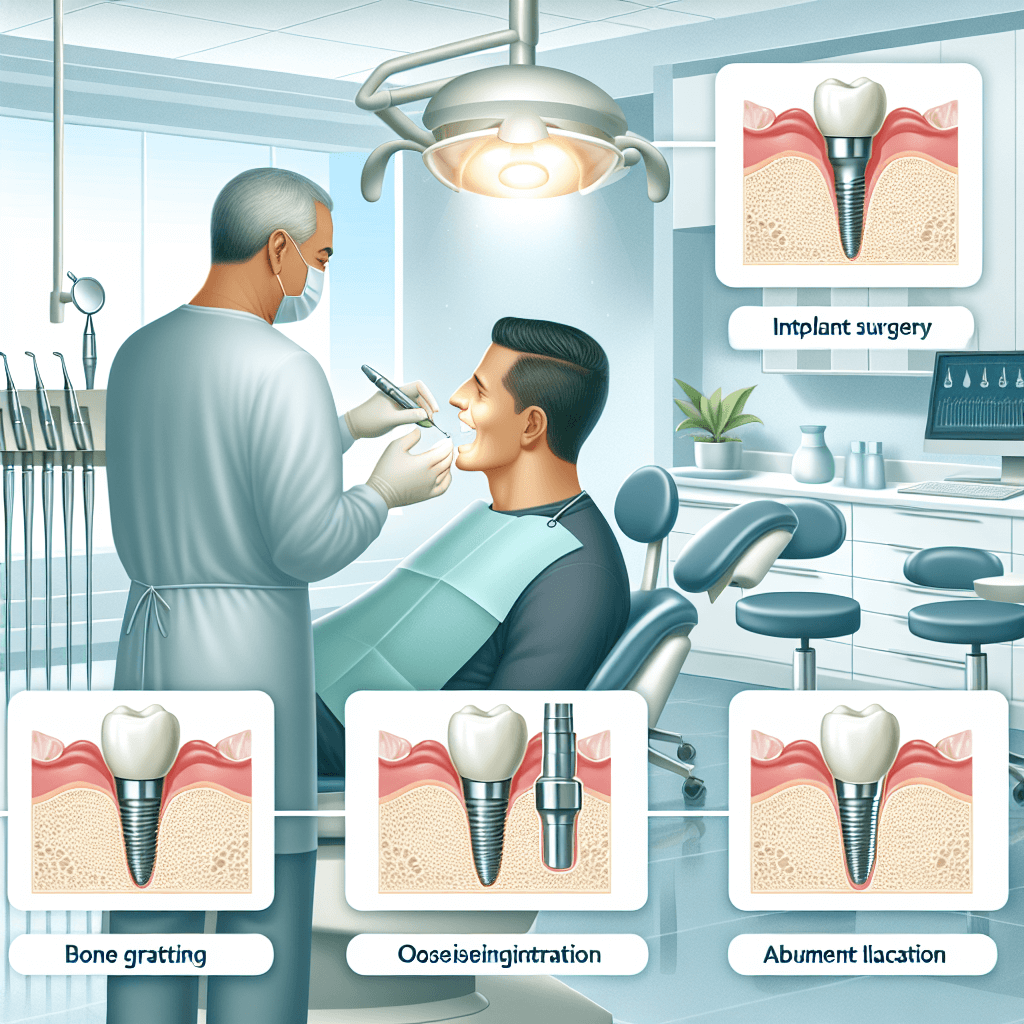Introduction to Implant Placement
With their dependability and aesthetically acceptable appearance for missing teeth, dental implants have transformed modern dentistry. Whether your reason for knowing the implant placement process is patient considering this option, dental student eager to learn, or dentist trying to improve her abilities, knowledge of this process is very vital. This thorough guide will lead you through every stage, so guaranteeing your knowledge and readiness.
Steps of Implant Placement
Step 1: Initial Consultation and Treatment Planning
An initial consultation comes first in the Dental Implant Placement process. The dentist assesses the patient’s general oral condition during this consultation to ascertain whether they qualify for dental implants. To evaluate the state of the jawbone, this calls for a careful inspection comprising X-rays and possibly CT scans.
This phase depends critically on treatment planning. The dentist will go over the patient’s medical background, current meds, and expectations. We will develop a thorough strategy including the sort of prosthetic to be utilized, the location of the implants, and their count.
Step 2: Bone Grafting and Site Preparation (if necessary)
In some cases, patients may not have sufficient bone density to support an Dental implant. When this occurs, bone grafting becomes necessary. Bone grafting involves adding bone or bone-like materials to the jaw to create a stable foundation for the implant.
This step can take several months as the graft needs time to integrate with the existing bone. Site preparation might also include treating periodontal disease or other oral health issues that could affect the success of the implant.
Step 3: Dental Implant Placement Surgery
The actual implant insertion operations can start once the site is ready. To reveal the bone, this entails a minor gum incision. The titanium implant is then firmly inserted into the bone once a hole has been bored there.
After that, the gum is sewed together and the implant is covered with a protective layer. Usually under local anesthetic, this operation guarantees the patient experiences least pain.
Step 4: Osseointegration and Healing Period
The procedure whereby an implant merges with the jawbone called osseointegration. This is a vital phase that guarantees the implant turns into a permanent and stable component of the mouth. Usually taking several months, osseointegration requires the patient to follow particular care recommendations.
Temporary restorations could be supplied during this healing period to preserve appearance and use. Scheduled regular follow-up visits will help to track development and guarantee proper integration of the implant.
Step 5: Abutment Placement
Setting the abutment comes next once osseointegration is finished. The abutment is a connector meant to hold the final crown in place. Reopening the gum allows one to attach the abutment to the implant.
The gum tissue is then let to naturally look after the abutment. Usually involving little pain for the patient, this stage is somewhat short.
Step 6: Restorative Phase and Final Crown Placement
The restoring phase comes last in the process of implanting a device. This entails setting the abutment’s custom-made crown upon top. Ensuring a flawless and natural look, the crown is made to match the color, form, and size of the patient’s original teeth.
Patients will visit for a last fitting appointment to make any required corrections and guarantee the crown fits exactly. This stage finishes the implant insertion process, therefore restoring the patient’s smile to have complete function and appearance.
Importance of Each Step
Initial Consultation and Treatment Planning
A good implant operation is set up by the first consultation. It lets the dentist compile the required information and design a customized treatment schedule. This stage guarantees early discovery of possible problems and quick resolution of them.
Crucially, the patient’s experience in this stage is Open and honest communication fosters confidence and trust, so guiding reasonable expectations throughout the whole process.
Bone Grafting and Site Preparation
Patients lacking enough bone density must first prepare sites and do bone grafting. This stage guarantees a strong basis for the implant, therefore greatly extending its lifetime and success possibilities.
Knowing the significance of this phase enables patients to value the time and effort needed to reach best outcomes. Good site preparation reduces problems and improves the general implant success rate.
Dental Implant Placement Surgery
The implantation of the implant actually marks a turning point in the process. The stability and orientation of the implant depend on accuracy and experience during this procedure. A well-placed implant promotes the eventual repair better and integrates more successfully.
Patients should be advised of their expectations both during and following the surgery. Clear post-operative guidelines enable speedier healing and help control pain.
Osseointegration and Healing Period
The basis of a strong and long-lasting implant is osseointegration. This time lets the body come to see the implant as normal component of the jaw bone. Patience in this stage pays off with a functional and safe implant.
During this time, patients have to strictly follow their treatment directions. Effective osseointegration depends on good oral hygiene and preventing too much stress on the implant site.
Abutment Placement
Placing the abutment is a relatively straightforward procedure, but its significance cannot be underestimated. It provides the necessary support for the final crown and ensures the gum tissue heals correctly around it.
Patients should understand that while this step is quick, it requires the same level of care and attention to detail as the previous steps. Proper healing around the abutment sets the stage for a natural-looking final restoration.
Restorative Phase and Final Crown Placement
The whole process comes to a conclusion at the final crown placement. It lets patients enjoy the advantages of their new implant totally by restoring complete function and aesthetics. This stage emphasizes the relevance of every one of the previous ones since any problems that arise during the process could influence the result at last.
Patients should be delighted about their new smile and confident. The lifetime of the implant and general dental health depend on routine follow-ups and care.
Common Challenges and How to Overcome Them
Dental Implant placement, while highly successful, is not without its challenges. Potential complications include infection, implant failure, and issues related to bone healing. Identifying these challenges early and addressing them proactively is key.
Infection
Infections can occur at any stage of the implant process, emphasizing the importance of maintaining a sterile environment and proper oral hygiene. Patients must follow post-operative care instructions diligently to prevent infections.
Implant Failure
Although rare, implant failure can occur due to various factors, including insufficient bone density or poor osseointegration. Regular monitoring and early intervention can mitigate these risks. In cases of failure, alternative treatments or additional procedures might be necessary.
Bone Healing Issues
Occasionally, the bone may not integrate well with the implant, leading to instability. This can be due to several factors, including the patient’s health and adherence to care guidelines. Bone grafting can address these issues and provide a solution for successful implant placement.
Post-Operative Care and Maintenance
Post-operative care is crucial for the success of dental implants. Proper care ensures successful healing and long-term functionality. Patients should follow these guidelines:
Immediate Post-Operative Care
After the implant surgery, patients should avoid disturbing the surgical area, maintaining a soft diet, and taking prescribed medications as directed. Following these steps reduces the risk of complications and promotes faster healing.
Long-Term Maintenance
Long-term success depends on diligent oral hygiene and regular dental check-ups. Patients should brush and floss regularly, avoiding hard or sticky foods that could damage the implant. Routine visits to the dentist ensure early detection and management of potential issues.
Regular Follow-Ups
Follow-up appointments are essential to monitor the implant’s integration and overall health. These visits allow the dentist to check for any signs of complications and provide professional cleaning and maintenance.
Case Studies and Testimonials
Real-life examples and testimonials highlight the transformative impact of dental implants. Consider the case of John, a 45-year-old patient who struggled with missing teeth for years. After undergoing implant placement, John experienced a significant improvement in his quality of life, enjoying his favorite foods and smiling confidently.
Dentists who have performed numerous successful implant placements share valuable insights. Dr. Smith, with over 20 years of experience, emphasizes the importance of patient education and meticulous planning. Lessons learned from these experiences contribute to best practices and ongoing advancements in implant dentistry.
Conclusion
Dental implants are a remarkable solution for missing teeth, offering both functional and aesthetic benefits. Understanding the detailed steps involved in implant placement helps patients and professionals appreciate the complexity and precision required for success.
For those considering dental implants, we encourage you to schedule a consultation with your dentist to explore this life-changing option. If you found this guide helpful, share it with others seeking information on implant placement.
By staying informed and engaged, you can achieve optimal oral health and enjoy the lasting benefits of dental implants. Visit DentxDental.com for more information and to connect with our team of experts.













